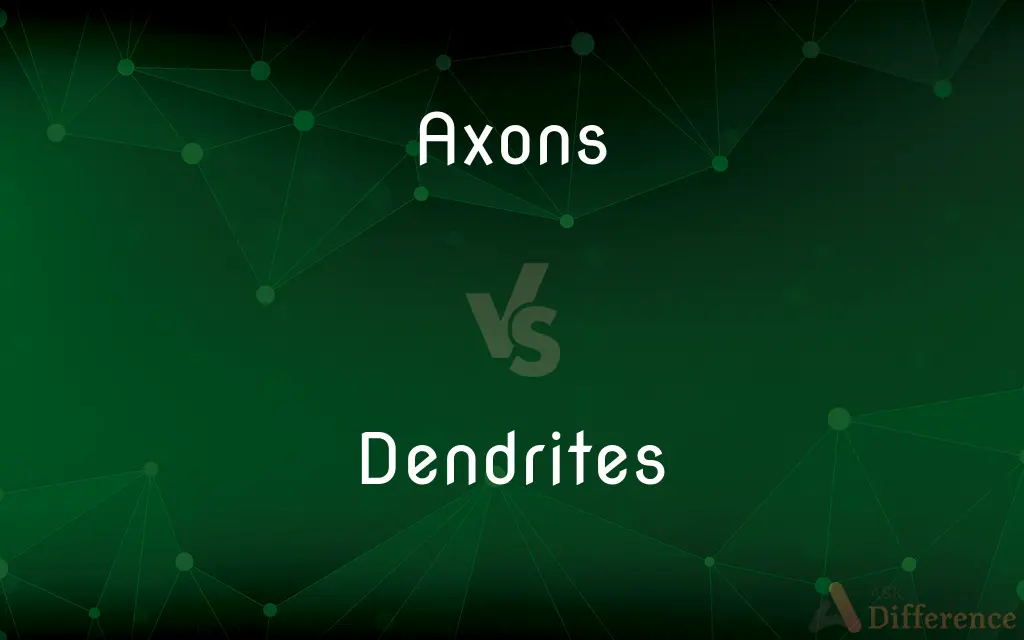Axons vs. Dendrites — What's the Difference?
By Tayyaba Rehman — Published on November 17, 2023
Axons transmit electrical impulses away from the neuron's cell body, while dendrites receive electrical signals from other neurons.

Difference Between Axons and Dendrites
Table of Contents
ADVERTISEMENT
Key Differences
Axons and dendrites are both integral components of neurons, but they serve distinct roles in neural communication. Axons, often long and slender, primarily function to transmit electrical impulses away from the neuron's cell body to other neurons, muscles, or glands. They typically have a consistent diameter and can be myelinated, which enhances the speed of neural transmission.
Dendrites, on the other hand, are short, branching structures that protrude from the neuron's cell body. They act as the primary receivers of signals from other neurons, collecting the electrical information via their numerous branches. Dendrites increase in complexity and branching as they approach the cell body, providing a vast surface area to receive signals.
One of the most notable structural differences between axons and dendrites lies in their terminals. Axons conclude with axon terminals or synaptic knobs, which release neurotransmitters into the synaptic cleft to communicate with the next neuron. Dendrites possess small protrusions called dendritic spines, which increase their receptive surface area.
While both axons and dendrites are crucial for neural communication, their unique structures and functions ensure that information flow within the neuron remains unidirectional. Typically, dendrites receive and process the signal, which then travels down the axon to be passed on to the next cell.
Comparison Chart
Function
Transmit electrical impulses away from the cell body.
Receive electrical signals.
ADVERTISEMENT
Length
Typically longer.
Shorter with branching structures.
Structure at end
Axon terminals or synaptic knobs.
Dendritic spines.
Myelination
Can be myelinated.
Typically not myelinated.
Complexity
Usually singular and consistent in diameter.
Branched and complex near the cell body.
Compare with Definitions
Axons
Long projections of neurons that transmit electrical impulses.
The axons of these neurons extend all the way from the spinal cord to the muscles in the legs.
Dendrites
The parts of nerve cells specialized in capturing incoming neural information.
A neuron's dendrites collect data from numerous other neurons.
Axons
Extensions of nerve cells responsible for sending signals to other cells.
Damage to axons can lead to impaired communication between neurons.
Dendrites
Neural structures that act as antennae, receiving inputs from other neurons.
The more dendrites a neuron has, the more information it can process.
Axons
The elongated segments of neurons facilitating long-distance communication.
In certain diseases, axons degenerate, leading to a loss of neural function.
Dendrites
Short, branched protrusions from the neuron's body.
Each neuron has a unique dendritic tree, reflecting its connections.
Axons
The primary output structures in neurons.
When stimulated, the axons carry the neural message to its destination.
Dendrites
Branching extensions from neurons that receive signals from other cells.
Dendrites are covered in tiny spines, increasing their receptive capacity.
Axons
Neural fibers that convey messages from the neuron's body.
Myelinated axons can transmit signals more rapidly than unmyelinated ones.
Dendrites
The receptive segments of neurons, gathering input for the cell to process.
Alterations in dendrites can affect a neuron's ability to integrate information.
Axons
The usually long process of a nerve fiber that generally conducts impulses away from the body of the nerve cell.
Dendrites
A mineral crystallizing in another mineral in the form of a branching or treelike mark.
Axons
Plural of axon
Dendrites
A rock or mineral bearing such a mark or marks.
Dendrites
A branched protoplasmic extension of a nerve cell that conducts impulses from adjacent cells inward toward the cell body. A single nerve may possess many dendrites. Also called dendron.
Dendrites
Plural of dendrite
Common Curiosities
What's the primary role of axons in neural communication?
Axons transmit electrical signals away from the neuron's cell body.
How do dendrites aid in a neuron's function?
Dendrites receive and process electrical signals from other neurons.
Why do dendrites have a branched structure?
The branching increases their surface area, allowing them to receive signals from multiple sources.
How do axons communicate with other cells?
They release neurotransmitters from their terminals into synapses, affecting the next cell.
Do dendrites release neurotransmitters like axons?
No, dendrites primarily receive signals; axons are responsible for transmitting them via neurotransmitters.
What is the significance of the branching structure of dendrites?
The branching increases dendrites' surface area, enabling them to receive signals from multiple sources.
Why are axon terminals crucial in neural communication?
Axon terminals release neurotransmitters into synapses, mediating communication with the next cell.
How do dendrites contribute to neural functioning?
Dendrites receive and process electrical signals from other neurons, acting as the primary input sites.
Can axons be covered in a fatty substance?
Yes, many axons are covered in myelin, a fatty substance that speeds up signal transmission.
Are axons always longer than dendrites?
Typically, axons are longer, but there are exceptions based on the neuron's specific function and location.
What primary role do axons serve in neurons?
Axons transmit electrical signals away from the neuron's cell body, facilitating communication.
Can a neuron have multiple axons or dendrites?
Neurons typically have one axon but can possess numerous dendrites.
Do dendrites play a role in memory formation and learning?
Yes, changes in dendritic structures and synapses contribute to memory and learning processes.
Are axons typically myelinated, and if so, why?
Yes, many axons are myelinated, which enhances the speed of electrical signal transmission.
Do both axons and dendrites have the capability to release neurotransmitters?
No, primarily axons release neurotransmitters at their terminals, while dendrites mainly receive signals.
How do axonal injuries impact neural communication?
Axonal injuries can disrupt signal transmission, leading to loss of function or sensory deficits.
How do axons and dendrites interact within a neuron?
Dendrites receive signals which are processed by the neuron, then the axon transmits the outcome to other cells.
Can dendrites transmit signals, like axons?
While dendrites mainly receive signals, they can propagate some electrical signals, but it's not their primary function.
How do the numbers of axons and dendrites affect a neuron's connectivity?
While neurons typically have one axon, multiple dendrites allow for increased connectivity and integration of signals from various sources.
What are dendritic spines, and how do they relate to dendrites?
Dendritic spines are small protrusions on dendrites, enhancing their receptive capabilities by forming synapses.
Why is the length of axons variable?
The length of axons varies depending on their role and location, with some spanning large distances within the body.
Do axons and dendrites have different diameters?
Yes, axons usually maintain a consistent diameter, while dendrites taper and have variable diameters due to branching.
Share Your Discovery

Previous Comparison
TIF vs. TIFF
Next Comparison
Cold Booting vs. Warm BootingAuthor Spotlight
Written by
Tayyaba RehmanTayyaba Rehman is a distinguished writer, currently serving as a primary contributor to askdifference.com. As a researcher in semantics and etymology, Tayyaba's passion for the complexity of languages and their distinctions has found a perfect home on the platform. Tayyaba delves into the intricacies of language, distinguishing between commonly confused words and phrases, thereby providing clarity for readers worldwide.














































